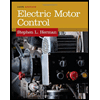
EBK ELECTRIC MOTOR CONTROL
10th Edition
ISBN: 9780100784598
Author: Herman
Publisher: YUZU
expand_more
expand_more
format_list_bulleted
Concept explainers
Question
Chapter 50, Problem 7SQ
To determine
Explain the necessity of resistor R in figure 50-4(B).
Expert Solution & Answer
Want to see the full answer?
Check out a sample textbook solution
Students have asked these similar questions
Two loads connected in parallel consume a total of 2.4 kW with a power factor of 0.8 lagging, both supplied at 120 V, 60 Hz. Knowing that one of the loads consumes 1.5 kW at a power factor of 0.707 lagging.
a. Determine a power factor of he second load
b. Correct the power factor to 0,9 lagging
Determine the maximum power that a load connected between a and b could consume.
Find Vx,V1,V3,V0 according to the case of the circuits using LVK
Chapter 50 Solutions
EBK ELECTRIC MOTOR CONTROL
Knowledge Booster
Learn more about
Need a deep-dive on the concept behind this application? Look no further. Learn more about this topic, electrical-engineering and related others by exploring similar questions and additional content below.Similar questions
- Q4arrow_forwardCalculate the value for V1, V2 and V3arrow_forwardPrelab Information Laboratory Preliminary Discussion Second-order RLC Circuit Analysis The second-order RLC circuit shown in figure 1 below represents all voltages and impedances as functions of the complex variable, s. Note, of course, that the impedances associated with R, RL, and Rs are constant independent of frequency, so the 's' notation is omitted. Again, one of the advantages of s-domain analysis is that we can apply all of the circuit analysis techniques learned for AC and DC circuits. ZI(s) Zc(s) Rs w RL ww + + VRS(S) VRL(S) VL(s) Vc(s) VR(S) R Vs(s) Figure 1: A second-order RLC circuit represented in the s-domain. To generate the s-domain expression for the output voltage, Vout(s) = VR(S), for the circuit shown in figure 1, we can apply voltage division in the s-domain as shown in equation 1 below. For equation 1 we define the following circuit parameters. RT=RS + RL + R where: R₁ = Total series resistance Rs Signal generator output resistance (fixed) Inductor internal…arrow_forward
arrow_back_ios
SEE MORE QUESTIONS
arrow_forward_ios
Recommended textbooks for you
